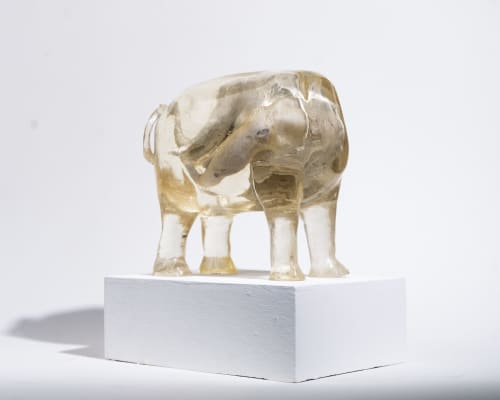The return of the 900-year-old Golden Boy statue to Thailand from the Metropolitan Museum of Art in New York marks a chapter in Thai art history. Previously smuggled out of Thailand in 1975 by the late art dealer Douglas Latchford, who was then indicted in 2019 for the looting and selling of Southeast Asian antiquities to auction houses and museums, Thais welcomed Golden Boy home in December last year. The statue is believed to depict the Hindu god Shiva or King Jayavarman VI who was responsible for establishing the Phimai stone castle. In Śūnyatā, the intrinsic value of actualised ideas in art is questioned in the face of a new era of repatriation of looted objects. The exhibition pays homage to classical beliefs in new forms.
A collection of ‘what ifs’ in the past, changes our present when presented with alternative decisions in our memory and legacy. The reminiscent feeling of the artworks challenges us to consider how ancient narratives and cultural practices are not merely historical artefacts but are dynamic components of our modern lives.
How may we consider the impact of these alternate histories on our current reality? By reimagining pivotal moments in the past, this exhibition invites us to explore a multitude of possible worlds shaped by different choices and outcomes. By engaging with these themes, Śūnyatā is a group exhibition showcasing the talented works of Tanakrit Polngam and Vayupad Ruttanapet, which sparks curiosity about the myriad paths history could have taken, encouraging us to reflect on the fragility and unpredictability of our reality.
Ultimately, Śūnyatā sparks curiosity and encourages us to embrace the diversity of potential perspectives. We carry with us a deeper and renewed appreciation for the enduring legacy of ancient narratives in shaping the course of human civilisation.
ด้วยการคืนรูปปั้น Golden Boy อายุกว่า 900 ปีกลับคืนสู่ประเทศไทยจากพิพิธภัณฑ์ The Metropolitan Museum of Art (New York) ที่ถูกลักลอบนำออกจากประเทศไทยในปี พ.ศ. 2518 โดยพ่อค้างานศิลปะผู้ล่วงลับ ดักลาส แลทช์ฟอร์ด ซึ่งต่อมาถูกตั้งข้อหาในปี พ.ศ. 2562 ฐานปล้นสะดมและขายโบราณวัตถุในเอเชียตะวันออกเฉียงใต้ให้กับที่ประมูลและพิพิธภัณฑ์ คนไทยให้การต้อนรับ Golden Boy กลับบ้านในเดือนธันวาคมปีที่แล้ว เชื่อกันว่ารูปปั้นนี้เป็นรูปเทพเจ้าพระศิวะในศาสนาฮินดูหรือพระเจ้าชัยวรมันที่ 6 ผู้รับผิดชอบในการสถาปนาปราสาทหินพิมาย ใน Śūnyatā คุณค่าที่แท้จริงของแนวคิดในงานศิลปะถูกตั้งคำถามเมื่อเผชิญกับยุคสมัยใหม่ของการส่งวัตถุ
ที่ถูกลักลอบนำออกไปกลับสู่ประเทศต้นทาง นิทรรศการนี้แสดงความเคารพต่อความเชื่อคลาสสิกในรูปแบบใหม่
“ถ้าหาก” การตัดสินใจที่แตกต่างในอดีต สามารถเปลี่ยนแปลงปัจจุบันของเราได้ “ถ้าหาก” เรื่องเล่าและตำนานความเชื่อ ไม่ได้เป็นเพียงเศษเสี้ยวของประวัติศาสตร์ แต่เป็นส่วนประกอบสำคัญของชีวิตในปัจจุบัน เราจะพิจารณาผลกระทบของประวัติศาสตร์ทางเลือกเหล่านี้ต่อความเป็นจริงในปัจจุบันได้อย่างไร?
นิทรรศการนี้เชิญชวนให้ทุกคนได้ลองจินตนาการและสำรวจความเป็นไปได้ที่หลากหลายในอดีต จากการตัดสินใจและผลลัพธ์ที่แตกต่างกัน โดยเชิญชวนให้ผู้ชมตีความและพิจารณาเกี่ยวกับเส้นทางประวัติศาสตร์ที่อาจเป็นไปได้มากมาย รวมถึงความเปราะบางและความไม่แน่นอนของความเป็นจริง
ผลงานของธนกฤต ได้มีการตีความตำนานความเชื่อและสัตว์โบราณในรูปแบบใหม่ ผ่านมิติของความเชื่อสมมติ เช่น สัตว์ในอุดมคติหรือสัตว์ศักดิ์สิทธิ์ตามความเชื่อทางศาสนาในสังคมไทย ในอดีตชาวบ้านเคยมองว่าสัตว์ที่เกิดมามีความผิดปกติไม่ใช่ลางร้าย แต่เป็นสัญลักษณ์ของความหวัง ความเป็นมงคล และโชคลาภ ธนกฤตได้เชิญชวนให้ผู้ชมพิจารณาว่าความเชื่อโบราณยังคงมีอิทธิพลในการสร้างตัวตนและบรรทัดฐานของสังคมสมัยใหม่อย่างไร ในขณะที่ผลงานของวายุพัดสำรวจแนวคิดที่ว่า เมื่อบรรทัดฐานดั้งเดิมก้าวไปข้างหน้า ผู้คนในยุคปัจจุบันจะพยายามค้นหาต้นกำเนิดของตัวเอง พร้อมทั้งผสมผสานวัฒนธรรมและประเพณี สร้างเส้นทางใหม่ที่มนุษย์เลือกที่จะยอมรับและเคารพรากฐานบรรพบุรุษ ในขณะเดียวกันก็ตั้งคำถามถึงการปฏิบัติที่สืบทอดกันมา
ในที่สุด Śūnyatā ทำให้เราสำรวจความหลากหลายของมุมมองที่เป็นไปได้อย่างลึกซึ้งและพิจารณาต่อมรดกที่ยั่งยืนของเรื่องเล่าโบราณในการกำหนดทิศทางของอารยธรรมมนุษย์


